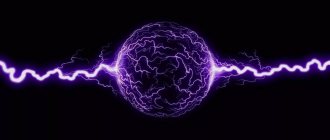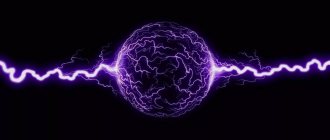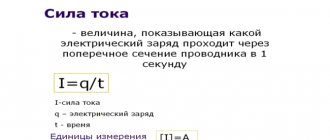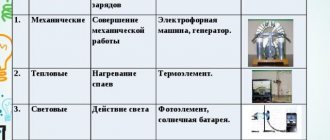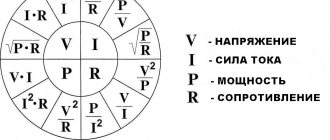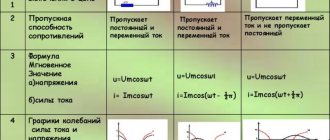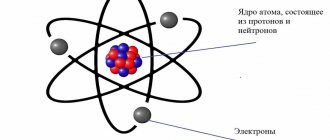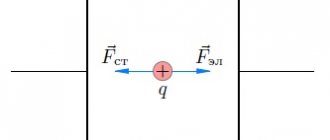We use electric heating devices every day without thinking about where the heat comes from. Of course, you know that thermal energy is produced by electricity. But not everyone knows how this happens, much less how to estimate the amount of heat generated. This question is answered by the Joule-Lenz law, promulgated in the century before last.
In 1841, the efforts of the English physicist Joule, and in 1842, the research of the Russian scientist Lenz, culminated in the discovery of a law, the application of which makes it possible to quantify the results of the thermal effect of electric current [ ]. Since then, many devices have been invented that are based on the thermal effect of current. Some of them are shown in Fig. 1.
Rice. 1. Heating devices
Basic Concepts
The basic definition can be formulated as follows: the amount of heat that a conductor generates is proportional to the current passing through it and the electrical resistance of the test section. Taking into account the classical relationships established by Ohm's law, this dependence can be expressed in terms of conductivity and the potential difference, which provokes the movement of charged particles.
Differential form
To move on to the differential form of the law, let us analyze the Joule-Lenz statement as applied to electronic theory. The increment in electron energy ΔW due to the work of electric field forces is equal to the difference in electron energies at the end of the path (m/2)*(u=υmax)2 and at the beginning of the path (mu2)/2, that is
Here u is the speed of chaotic movement (vector quantity), and υmax is the maximum speed of the electric charge at a given moment in time.
Since it has been established that the speed of chaotic motion coincides with the maximum with equal probability (in the direction and in the opposite direction), then the expression 2*u*υmax is equal to zero on average. Then the total energy released during collisions of electrons with atoms forming nodes of the crystal lattice is:
This is the Joule-Lenz law, written in differential form. Here γ is the matching coefficient, E is the field strength.
Integral form
Let us assume that the conductor has a cylindrical shape with a cross-section S. Let the length of this conductor be l. Then the power P released in the volume V= lS is:
where R is the total resistance of the conductor.
Considering that U = I×R, from the last formula we have:
- P = U×I;
- P = I2R;
- P = U2/R.
If the current value changes over time, then the amount of heat is calculated using the formula:
This expression, as well as the above formulas, which can be rewritten in the same form, is usually called the integral form of the Joule-Lenz law.
The formulas are very convenient for calculating the current power in heating elements. If the resistance of such an element is known, then knowing the voltage of the household network it is easy to determine the power of the device, for example, an electric kettle or a soldering iron.
Derivation of Ohm's and Joule-Lenz's laws from classical electronic representations
What is the nature of current carriers in metals? In 1901, Rikke carried out experiments: direct current was passed through 3 cylinders installed on top of each other for 3 years. A charge equal to 3.5·10 6 C was passed through. Weighing showed a constant weight of the cylinders. Examination of the ends of the cylinders showed no traces of substance transfer. From this it was concluded that the charge carriers are not ions, but electrons discovered by Thompson in 1897.
To identify charge carriers with electrons, it was necessary to determine the sign and magnitude of the specific charge of the carriers.
If there are easily moving charged particles in the metal, then when the metal conductor is decelerated, these particles must continue to move by inertia for some time, as a result of which a current pulse will arise in the conductor and some charge will be transferred.
Mandelstam and Papaleksi carried out such an experiment in 1913 - they set a coil with a wire in rapid torsional vibration around its axis. A telephone was connected to the ends of the coil, in which a sound was heard due to current pulses. A qualitative result was obtained - a current pulse was recorded.
Tolman and Stewart in 1916 obtained a quantitative result. A coil with a wire 500 m long was rotated at a speed v=300 m/s. The coil was braked sharply and the charge flowing in the circuit during braking was measured using a ballistic galvanometer. The calculated value of the charge-to-mass ratio e/m was very close for electrons. Thus, it was proven that the current carrier is electrons. Based on the concept of free electrons, the classical theory of electrical conductivity of metals
assuming that:
— electrons in a metal behave like molecules of an ideal gas;
— the movement of electrons obeys the laws of classical mechanics;
— the interaction of electrons is reduced to collisions with ions of the crystal lattice;
— the forces of interaction between electrons can be neglected and they do not collide with each other;
— electrons in the absence of an electric field move chaotically.
Let us calculate the current density j in the conductor arising under the influence of a field of intensity E.
By definition, current density j = ne is the charge transferred through a unit area S = 1 m 2 per unit time t = 1 s; n is the concentration of electrons, e is the charge of an electron, and is the average speed of the ordered movement of electrons.
Each electron is acted upon by a force F = eE = ma, so the electron acquires acceleration
and by the end of the free run he will reach the speed
, and average speed =vmax/2.
If is the average speed of thermal chaotic motion of electrons, and the average free path of electrons is , then the average time between collisions =
. Substituting into the formula for we get:
.
Substituting into the formula for j, we get
,
those. The current density is directly proportional to E, and this is the expression of Ohm's law in differential form. If we put that
then j
= γ
E
.
Specific conductivity γ
T, therefore conductivity decreases with increasing temperature, and resistivity
increases with increasing temperature. By the end of the free path, the electron acquires kinetic energy
It is assumed that all the energy during a collision is transferred to a node of the crystal lattice and turns into heat. In 1 s, an electron experiences 1/2 collisions, which means it releases the same amount of heat. If there are n electrons in a unit volume, then the amount of heat released per unit volume per unit time
.
Thus,
— expression of the Joule-Lenz law in differential form.
When an electric current flows through a conductor, it has a thermal effect, during which a certain amount of heat is released. To calculate it, the Joule-Lenz law is used, which is widely used in the design and manufacture of all devices powered by electricity.
The essence of the heat law
Law of Electromagnetic Induction - Formula
The scientists mentioned above (Joule Lenz) almost simultaneously (1841-1842) established the dependence of heating on current strength. For a visual experiment, you can use the following kit:
- the conductor is placed in a container of water;
- the thermometer will measure the change in liquid temperature when the circuit is connected to a power source;
- Using a voltmeter and an ammeter, the voltage and current at the control points are clarified.
A similar experiment can be reproduced in a container with a salt solution, which has a certain conductivity
According to Ohm's law, current (I) can be determined through voltage (U) and electrical resistance (R):
I=U/R.
Write down the work performed (A) as follows:
A = I * U * t = I * (I*R) * t = (U/R) * U * t = I2*R*t = (U2/R) * t.
Here t denotes the corresponding time interval.
At this stage, we should recall the first law of thermodynamics, which determines the conservation of energy in a closed system. This postulate allows us to describe the phenomenon under consideration using the created formula. This assumes that the amount of heat (Q) is equal to the work done (A). Final expression (Lenz's law):
Q = I2*R*t = (U2/R) * t = I * U * t.
The essence of the phenomenon is explained by the collision of charged particles with conductor molecules. If the sample is a solid material, we are talking about electrons and lattice components, respectively.
Formulation
The Joule-Lenz law is formulated verbally as follows: the heat power that is released in a conductor element at the moment an electric current flows in it has a proportional dependence of the electric field density multiplied by the intensity.
It can be formulated differently as follows: energy flowing through a conductor moves an electric charge in an electric field. So, the electric field does work. The work is done thanks to conductive heating. Energy is converted into heat.
However, due to excessive conductive heating using current and electrical equipment, the wiring and the devices themselves may be damaged. Severe overheating is dangerous when there is a short circuit in the wires. Because of this, conductors can carry a large current load.
As for the integral shape of thin conductors, the Joule-Lenz rule or equation sounds like this: the heat that is released over time in a specific section of an electrical circuit is determined by the square product of the current force and the resistance of the section.
Note! The Joule-Lenz law is quite general in nature because it does not depend on the nature whose force is generated by the electric current.
From practice, it can be argued that it is valid both for electrolytes and conductors and semiconductors.
Simplified wording
Reducing losses
When transmitting electrical energy from the source of its generation - thermal, nuclear, hydroelectric power plants or environmentally friendly installations like solar panels, it partially turns into heat and goes into the atmosphere - the conductor heats up due to the resistance exerted on the moving charges. The consumer pays for these losses. To reduce them, based on the formula Q = I2Rt, you can:
- Reduce the resistance of conductors - instead of the common aluminum, use copper, silver, or other material with higher conductivity than Al. It is impossible to obtain sufficient quantities of the mentioned metals to conduct power lines for thousands of kilometers.
- It is impossible to reduce the current passage time; the consumer must receive electricity continuously.
- Reducing the electric current is the only practical solution, taking into account the quadratic dependence.
It is not for nothing that electricity is transported over long distances with low current, but at high voltage: 110, 220 or more kV. With this potential, the line length can reach 150 and 250 km, respectively. Transformers increase and decrease voltage.
Lenz's experiments
Let's fast forward to the 19th century, the era of accumulation of knowledge and preparation for the technological leap of the 20th century. An era when all over the world various scientists and simply self-taught inventors discover something new almost every day, often spending a huge amount of time on research and, at the same time, not presenting the final result.
One of these people, the Russian scientist Emilius Christianovich Lenz, was fascinated by electricity, at the then primitive level, trying to calculate electrical circuits. In 1832, Emilius Lenz was “stuck” with the calculations, since the parameters of his simulated circuit “energy source – conductor – energy consumer” varied greatly from experiment to experiment. In the winter of 1832-1833, the scientist discovered that the cause of the instability was a piece of platinum wire that he brought from the cold. When heating or cooling a conductor, Lenz also noticed that there was a certain relationship between the current strength, electrical resistance and temperature of the conductor.
At certain parameters of the electrical circuit, the conductor quickly thawed and even warmed up slightly. There were practically no measuring instruments in those days - it was impossible to accurately measure either current or resistance. But this was a Russian physicist, and he showed ingenuity. If this is an addiction, then why shouldn't it be reversible?
In order to measure the amount of heat generated by the conductor, the scientist constructed the simplest “heater” - a glass container in which there was an alcohol-containing solution and a platinum spiral conductor immersed in it. By applying different amounts of electric current to the wire, Lenz measured the time it took for the solution to heat up to a certain temperature. Sources of electric current in those days were too weak to heat the solution to a serious temperature, so it was not possible to visually determine the amount of evaporated solution. Because of this, the research process was very drawn out - thousands of options for selecting the parameters of the power source, conductor, long measurements and subsequent analysis.
Practical significance
Ohm's law for a heterogeneous area
As a rule, they operate with current. It is by this parameter that the electron density in a certain cross section is determined. Taking into account the parameters of the material (impurities), it is easy to establish operating heating dependencies. To calculate the amount of heat in the conductor, the formula takes the following form:
Q = a* I2 * R * t.
If the special coefficient a=1, the unit of measurement is joule.
For convenience, the derivative value a = 0.24 is used. With this value of the correction factor, Lenz’s formula allows one to calculate the heat release in “small calories”. A single quantity is required to heat one gram of water by one degree Celsius.
Reduced energy loss
The formula corresponding to Joule Lenz's law explains the real efficiency of power lines. When operating the corresponding systems, heating the conductors does not perform a useful function. This process requires additional energy.
To calculate, you can consider the formula:
Rpr = Rpr * (Pn2 / Un2),
Where:
- Rpr (Pn) – power consumption of the conductor (load);
- Rpr – electrical resistance;
- Un – voltage of the power line of the connected consumer.
Conductivity is a constant indicator determined by the material and the amount of impurities. The temperature dependence can be neglected in most cases. According to the formula, losses can be reduced by increasing the voltage in the load. However, this method is associated with a deterioration in the overall level of security. Increasing the insulation layer in combination with other measures increases the cost of the corresponding products. On the other hand, the use of high-quality materials with high conductivity is accompanied by additional costs when creating power lines.
Choosing wires for circuits
According to current rules, cable products for transmitting electricity are selected taking into account the permissible heat generation. Calculations are performed using the formulas discussed in the publication. In addition to long-term exposure, the possibility of maintaining the integrity of the cores in an emergency short circuit is taken into account.
Acceptable cable parameters when installing hidden wiring.
To simplify the choice, special PUE standards have approved recommended values for popular aluminum (copper) conductors. The picture shows an example for hidden wiring. Similar tolerances are established for overhead power lines. It is recommended to purchase cable products with a reserve that will prevent dangerous situations when connecting powerful additional loads.
Electric heating devices
If you connect two incandescent lamps of different power in parallel in one circuit, you can visually determine the difference in glow. The heat generated is distributed in this way. The same principle is used when creating heating devices. The functional unit “TEN” is made using nichrome wire or other material with high resistivity. This area is characterized by high temperatures.
Induction is used for remote heating. The hob's electromagnetic generator paired with a coil creates a field that generates currents in the bottom of the cookware. This ensures a directed increase in the temperature of the bottom region.
For your information. In a conducting circuit, under certain conditions, self-induction occurs. This phenomenon is observed when an alternating current is passed, which changes the magnetic flux and provokes the formation of an electromotive force.
Fuses
In all the situations presented, the passage of current increases the temperature of the conductor. When the force of thermal influence increases at a certain level, the material is destroyed. This mechanism is used to create fuses. Calculation of products is carried out on the basis of the considered formulas. In this case, the determining value is the combustion time of the insert.
Products in this category are produced in a wide range. Separate classes are grouped by currents and standard sizes. Separation according to the type of design (fork, knife) is used. Depending on the voltage, response time criteria are established.
Physical meaning of the Joule–Lenz law
The law can be explained as follows: current flowing through a conductor represents the movement of an electric charge under the influence of an electric field. Thus, the electric field does some work. This work is spent on heating the conductor.
In other words, energy transforms into another quality – heat.
But excessive heating of current-carrying conductors and electrical equipment should not be allowed, as this can lead to damage. Severe overheating is dangerous during short circuits of wires, when fairly large currents can flow through the conductors.
In its integral form for thin conductors, the Joule–Lenz law is as follows: the amount of heat that is released per unit time in the section of the circuit under consideration is determined as the product of the square of the current strength and the resistance of the section.
Mathematically, this formulation is expressed as follows:
Q = ∫ k • I² • R • t,
in this case Q is the amount of heat released;
I – current value;
R - active resistance of conductors;
t – exposure time.
The value of the parameter k is usually called the thermal equivalent of work. The value of this parameter is determined depending on the bit depth of the units in which the values used in the formula are measured.
The Joule-Lenz law is quite general in nature, since it does not depend on the nature of the forces generating the current.
From practice, it can be argued that it is valid both for electrolytes and conductors and semiconductors.
Kirchhoff's laws
Kirchhoff's laws establish the relationship between currents and voltages in electrical circuits. Kirchhoff's laws are of particular importance in electrical engineering because of their versatility, as they are suitable for solving any electrical problems.
Kirchhoff's first law states that the algebraic sum of the currents at any node in any circuit is equal to zero.
Or in other words, the sum of all currents flowing into a node is equal to the sum of all currents flowing out of the node.
Let's consider Kirchhoff's first law using an example:
Here I2 and I4 are incoming currents, and I1 and I3 are outgoing currents
Then, according to Kirchhoff’s rule, we can write:
I1 + I2 - I3 +I4 = 0 or I2 + I4 = I1+ I3
Kirchhoff's second law states that the algebraic sum of the voltage drops along any closed circuit circuit is equal to the algebraic sum of the emf acting along the same circuit.
In other words, when completely bypassing the circuit, the potential, changing, returns to its original value. A special case of the second rule for a circuit consisting of one circuit is Ohm's law for this circuit.
When drawing up a stress equation for a circuit, you need to choose the positive direction of traversing the circuit. In this case, the voltage drop on the branch is considered positive if the direction of bypass of this branch coincides with the previously selected direction of the branch current, and negative otherwise.
Kirchhoff's rules are valid for linear and nonlinear circuits for any type of change in currents and voltages over time.
What is it measured in?
The unit of heat measurement is the joule. The formula consists of voltage, measured in volts, current, measured in amperes, and time, measured in seconds. Then it turns out that the indicators will be measured in joules or one volt, multiplied by an ampere and a second.
Unit of measurement of heat generated by electricity
What formula expresses
At the moment, there are two formulas according to the mathematical standard of two scientists, in addition to the topic of how to find the joule formula. According to the first, you need to multiply the intensity with the electric field density, and according to the second, you need to make an integral from the product of the thermal equivalent of work, the amount of heat generated, the magnitude of the current, active conductive resistance and time. The value will be determined depending on the digit capacity of the units in which the formula values are measured.
Formula for expressing a mathematical and physical law
What kind of law is this
The Joule-Lenz law definition states that it is a physical standard that determines the quantitative form of the measure of the thermal effect of electric current. In the nineteenth century, independently of each other, Joule and the Russian scientist Lenz began to study how conductors heat up when an electric current passes and found a certain pattern. They learned that when an electric current passes through a conductor element, heat is generated, which is equal to the current strength, time and conductor resistance.
Note! This pattern was named law in honor of the two scientists. It is worth pointing out that this pattern has been actively used from the moment of its discovery to the present day and helps solve many issues related to electrical engineering.
The history of the appearance of the formulation of the law of scientists
Where and how it is used
The Joule-Lenz law is actively used in electrical engineering, electrodynamics and other areas of physics. It is used both in everyday life and in industry.
For example, thanks to it, incandescent lamps and electric heating devices are created. They contain a heating element that acts as a conductor with high resistance. Thanks to this element, the heat generated in the area is localized. It will be released as the resistance increases with increasing conductor length and the choice of a specific alloy.
Note! It is also used to calculate the reduction of energy losses. The release of heat from the current leads to a decrease in energy. At the moment of its transmission, power depends linearly on the voltage and current strength, and heating depends on the current strength in a quadratic manner. For this reason, when increasing the voltage and decreasing the current before electrical energy is supplied, this action will be beneficial. When the voltage increases, electrical safety will decrease. To improve electrical safety, you need to increase the load resistance and mains voltage.
It is worth pointing out that it affects the selection of conductors for electrical circuits, since due to the wrong choice, the conductor may begin to become very hot and may also begin to catch fire. This occurs when the permissible current values are exceeded and a small amount of energy is released. The heating of conductors is harmful, so energy is lost and heat is transferred from the source to the user.
To reduce this loss, the current is reduced and the source voltage is increased with the remainder of the transmitted power. To avoid insulating electrical breakdown, it rises to a height on a high-voltage electrical transmission line that connects large power stations with cities and towns.
Scope of application
In general, the Joule-Lenz law is a rule invented by two scientists to determine how much heat an electric current gives off. This heat is expressed by the multiplication of twice the current, time, and resistance of the conductor and is measured in volts times amperes and seconds. It is actively used both in everyday life and in industry, both in studying the factor of heat loss and in the creation of incandescent lamps and electric heating installations. It is often used when choosing between wires in an electrical circuit.
General information
In 1941, the English physicist James Joule and, independently of him, in 1942, the Russian scientist Emilius Lenz, discovered the Joule-Lenz equation. It allows you to calculate using the formula the amount of heat in an electrical circuit released when an electric current passes through a conductor. The amount of heat generated by a conductor when current flows through it depends on the voltage, time, current strength and resistance of the conductor. The discovery made it possible to accurately calculate the circuits of various devices when designing them.
Before formulating the Joule-Lenz law, one should consider and understand the physical meaning of the basic and derivative quantities on which depends how much heat a conductor releases when an electric current passes through it.
Potential difference
It has been scientifically proven that every substance consists of atoms, which also consist of elementary or subatomic particles. These include the following: electrons, protons and neutrons. The atom in the initial state has a neutral charge, since the number of protons and electrons are equal and, therefore, the equality of positive and negative charges is true, and they cancel each other.
However, cases arise when an atom “captures” an electron from another atom. If an atom captures an electron, it is called a negative ion, and when it loses it, it becomes a positive ion. As a result of the loss or attraction of a subatomic negatively charged particle, an electromagnetic field is generated, the component of which depends on the charge of the ion.
The difference between the positive and negative components is the voltage, the unit of which is the volt (symbol: V or V). The greater the difference, the greater the voltage. In some sources it is also called potential difference, the value of which can be measured using a voltmeter or calculated using formulas. When potentials with opposite signs are connected, an electric current is formed, which represents the ordered movement of charged particles and, under the influence of the force of an electromagnetic field, has a vector direction.
In the scientific literature you can find the following definition: electrical voltage is the work that is performed when a point charge moves. Thus, 1 V is the voltage between two point positive and negative charges equal to 1 C, the movement of which requires the energy of an electromagnetic field of 1 J. Auxiliary units of measurement are the following: 1 kV = 1000 V, 1 MV = 10 6 V, 1 mV = 10^(-3), etc.
You might be interested in The design of a thermocouple, its types and operating principle
Current strength
Current strength (I) is a value equal to the number of charged particles that pass through a conductor per unit time. The unit of measurement is ampere (A), and an ammeter can be used to measure its value. The device is connected in series with the consumer in an electrical circuit. If an amount of charge equal to 1 C passes through the cross-sectional area of a conductor in 1 second, then this value is a current of 1 A.
The mathematical notation for finding the current strength is: I = Qz / t, where Qz is the charge value, and t is the unit of time. In addition, there are additional units of measurement: 1 mA = 10^(-3) A, 1 kA = 1000 A, etc. Electric current is of the following types:
- Variable.
- Permanent.
Alternating current obeys a certain law, which characterizes the change in amplitude and direction of flow. The main characteristic is the frequency, according to which the division into sinusoidal and non-sinusoidal currents occurs. The graph of a sinusoidal current type is a sinusoid, the formula of which depends on the maximum amplitude Imax and angular frequency w. It has the following form: i = Imax * sin (w * t).
To calculate the angular frequency value, you need the value of the current frequency in the network (f), which is substituted into the formula: w = 6.2832 * f. Direct current does not change the direction of its movement through a conductor, but its value may change.
Electrical resistance
Based on their electrical conductivity, substances can be classified into conductors, semiconductors and dielectrics. The first type includes all substances that conduct current well. This feature is determined by the presence of free charge carriers, information about which can be obtained from the electronic configuration of the elements of D. I. Mendeleev’s periodic system.
Conductors include the following substances: metals, electrolytes and ionized gas. In metals, electrons are charge carriers. In liquids (electrolytes), charge carriers are anions and cations: the former have a positive charge, and the latter have a negative charge. During electrolysis, anions are attracted by the electrode, which is negatively charged (cathode), and cations are affected by the positive charge of the anode. The function of charge carriers in gases is performed by negatively charged electrons and ions.
As the temperature of the conductor increases, atoms interact with each other, as a result of which the crystal lattice is destroyed and free charge carriers appear. When current flows, interaction occurs with the lattice nodes and with the electrons of the conductor, during which the movement of ordered charged particles slows down and thermal energy is released, and then again the speed of their movement returns to its original state, due to the influence of the electromagnetic field. This physical property is called the electrical resistance of a conductor, and when it is heated, its value increases.
You might be interested in: Concept, types and properties of electric current
Semiconductors are substances that conduct current only under certain conditions. The function of charge carriers is performed by electrons and holes. Under any influence of external energy (for example, thermal), the force of attraction between the nucleus and electrons decreases, during which some of them “break out” and become free, and holes form in their place.
An electromagnetic field of a positive component is formed and a neighboring subatomic particle with a negative charge is attracted to it. This process is repeated and causes the holes to move. The resistance of a substance (conductor or semiconductor) depends on the following factors:
- Temperature indicators.
- Type of substance.
- Lengths.
- Sectional area.
- Current and voltage values.
- Type of current.
Dielectrics are a group of substances that cannot conduct current because they do not contain any electrical charge carriers. Resistance or electrical conductivity is denoted by the letter R and is the interaction of charged particles moving in an orderly manner with the nodes of the crystal lattice. Its unit of measurement is Om.
Power characteristic
Electric current power (P) is the amount of work it does per unit of time. For direct and alternating currents, power is calculated using different ratios. In a direct current circuit, the values of its strength (I) and voltage (U) are equal to instantaneous values. The power formula is written as follows: P = U * I. For a circuit in which Ohm’s law is observed, the formula takes the following form: P = sqr (I) * R = sqr (U) / R.
For a complete circuit, the formula includes the value of the electromotive force (e): P = I * e. If you need to take into account the value of the internal resistance of the power source (Rin), then the formula must be corrected under the condition of absorption (use in an electric motor circuit or when charging a battery) as follows: P = I * e - sqr (I) * Rin = I * (e - (I * Rin)).
If there is a generator or galvanic element in the circuit (condition for the release of electricity), the formula takes the following form: P = I * (e + (I * Rin)). However, this formula cannot be used to calculate AC power because it changes over time. In AC circuits there is the concept of active, reactive and apparent power:
- Active is determined taking into account the root-mean-square values of U and I, as well as the phase shift angle (a): Pa = I * U * cos (a).
- Reactive (Qр): Qp = U * I * sin (a).
- Full (S): S = sqrt (sqr (Pa) + sqr (Qp)).
The value of Qp>0 if there is an inductive load in the circuit, and if there is a capacitive load - Qp<0. The unit of measurement is watt (W). A current of 1 A at a voltage of 1 V has a power of 1 W.
You might be interested in Calculating the resistance of parallel connections of resistors
Why does the conductor get hot?
How is the heating of the conductor explained? Why does it heat up and not remain neutral or cool down? Heating occurs due to the fact that free electrons moving in a conductor under the influence of an electric field bombard the atoms of metal molecules, thereby transferring to them their own energy, which turns into heat. To put it quite simply: when overcoming the material of the conductor, the electric current, as it were, “rubs” and collides with electrons on the molecules of the conductor. Well, as you know, any friction is accompanied by heating. Consequently, the conductor will heat up while electric current runs through it.
It also follows from the formula that the higher the resistivity of the conductor and the higher the current flowing through it, the higher the heating will be. For example, if you connect a copper conductor (resistivity 0.018 Ohm mm²/m) and an aluminum conductor (0.027 Ohm mm²/m) in series, then when electric current flows through the circuit, aluminum will heat up more than copper due to its higher resistance . Therefore, by the way, it is not recommended to twist copper and aluminum wires together in everyday life - there will be uneven heating at the point of twisting. The result is burning with subsequent loss of contact.
Why do conductors heat up?
Electric current is the ordered movement of charged particles. In conductors, these particles are negatively charged electrons. The effect of an electric field imparts additional kinetic energy to electrons. As they move, they collide with atoms (or molecules) of the conductor, releasing part of the acquired energy. For this reason, the internal energy of the substance begins to increase, which leads to an increase in temperature and the release of heat.
Rice. 1. Electric current in a conductor heats the conductor
If you take an ordinary incandescent light bulb and connect it to a voltage source through a rheostat (variable resistance), you can observe the thermal effect from the flow of current. By gradually increasing the current, we can first feel by touch that the glass bulb of the light bulb will gradually begin to heat up, and then we will see how the red-hot filament begins to glow.
Note that in this experiment the lead wires do not heat up much and do not glow. This happens because the resistance of the filament is much greater than the resistance of the lead wires.
Physical meaning
Let's remember how electric current flows through a metal conductor. As soon as the electrical circuit is closed, under the influence of EMF, the movement of free electrons is ordered, and they rush to the positive pole of the power source. However, on their way there are orderly rows of crystal lattices, the atoms of which create obstacles to ordered movement, that is, they offer resistance.
Part of the energy of moving electrons is spent on overcoming resistance. In accordance with the fundamental law of conservation of energy, it cannot disappear without a trace. This is what turns into heat, causing the conductor to heat up. The accumulated thermal energy is radiated into the surrounding space or heats other objects in contact with the conductor.
Figure 2 shows a diagram of an experiment demonstrating the law of the thermal effect of current heating a section of wire in an electrical circuit.
Rice. 2. Thermal effect of current
The phenomenon of heating conductors has been known almost since the creation of electric current, but researchers could not then explain its nature, much less propose a way to estimate the amount of heat generated. This problem is solved by the Joule-Lenz law, which we use to this day.
Practical benefits of the Joule-Lenz law
When heated strongly, one can observe the emission of the visible spectrum of light, which occurs, for example, in an incandescent light bulb. Weakly heated bodies also emit thermal energy, but in the range of infrared radiation, which we do not see, but can feel with our thermal receptors.
It is impossible to allow the conductors to become very hot, since excessive temperature destroys the structure of the metal, in other words, it melts it. This can lead to damage to electrical equipment and may also cause a fire. In order to prevent critical heating parameters, it is necessary to make calculations of thermal elements using formulas describing the Joule-Lenz law.
Having analyzed the expression U2/R, we are convinced that when the resistance tends to zero, the amount of heat released tends to infinity. This situation occurs during short circuits. This is the main danger of short circuit.
To combat short circuits use:
- circuit breakers:
- electronic protective units;
- fuses;
- other protective devices.
Equation in differential form
Sometimes it happens that the magnitude of the current remains unknown, but there is accurate data on what the voltage is in a section of the circuit. In this case, it is also worth using Ohm's law. Based on the fact that I = U/R, we can present the Joule-Lenz formula in differential form:
Therefore, two equations can be used to determine the amount of heat generated by a conductor when exposed to an electric current. But their use is possible only in cases where the work and power of the electric current are spent exclusively on heat generation, and there are no other energy consumers. The unit of heat generated is the joule: 1 J = 1 V × 1 A × 1 s.
Practical application of the law in human everyday life The Joule-Lenz Law is clearly applied in practice when operating household electrical appliances. As everyone knows, in order to heat an electric kettle, use a hairdryer, iron or soldering iron, you need to convert electricity into heat. The glow of an incandescent lamp occurs due to the presence of a tungsten filament, which, at high voltage, can illuminate everything around.
It is worth noting that obtaining heat energy from electricity is quite beneficial, as it helps to avoid energy losses. It is enough just to reduce the current to equalize the amount of heat received from the device. This also increases electrical safety and regulates the load on the mains voltage.
But the conductor should not be allowed to become very hot. Under the influence of high temperature, the structure of the metal is destroyed or, to put it simply, it begins to melt. This can cause a short circuit, which in turn leads to the failure of electrical equipment or even a fire. To avoid short circuits, protective blocks, fuses and circuit breakers are used.
The application of the law in practice makes a person’s life very convenient, so we can definitely conclude that this is a kind of brilliant achievement on which all electrical engineering rests. Today, almost every household appliance in any home runs on electricity, and this work is based on the relationship between current and thermal energy. The main thing is to carry out the correct calculations to prevent overheating of parts in the device.
Application and practical meaning
The direct conversion of electricity into thermal energy cannot be called economically profitable. However, from the point of view of the convenience and accessibility of modern humanity to sources of electricity, various heating devices continue to be widely used both in everyday life and in production.
Let's list some of them:
- electric kettles;
- irons;
- hair dryers;
- cookers;
- soldering irons;
- welding machines and much more.
Figure 3 shows household heating appliances that we often use.
Rice. 3. Household heating appliances
The use of thermal power in the chemical, metallurgical and other industrial sectors is closely related to the use of electrical energy.
Without knowledge of the physical Joule-Lenz law, it would be impossible to construct a safe heating device. This requires calculations that cannot be done without using the formulas we have discussed. Based on calculations, materials with the required resistivity are selected, which affects the heating capacity of the devices.
Without exaggeration, the Joule-Lenz law can be called brilliant. This is one of those laws that influenced the development of electrical engineering.
Application of the Joule-Lenz law in life
The discovery of the Joule-Lenz law had enormous consequences for the practical applications of electric current. Already in the 19th century, it became possible to create more accurate measuring instruments based on the contraction of a wire spiral when heated by a flowing current of a certain magnitude - the first dial voltmeters and ammeters. The first prototypes of electric heaters, toasters, and melting furnaces appeared - a conductor with a high resistivity was used, which made it possible to obtain a fairly high temperature.
Fuses and bimetallic circuit breakers (analogs of modern thermal protection relays) were invented, based on the difference in heating of conductors with different resistivities. And, of course, having discovered that at a certain current strength, a conductor with high resistivity can heat up red-hot, this effect was used as a light source. The first light bulbs appeared.
A conductor (carbon stick, bamboo thread, platinum wire, etc.) was placed in a glass flask, air was pumped out to slow down the oxidation process and an undamped, clean and stable light source was obtained - an electric light bulb.
